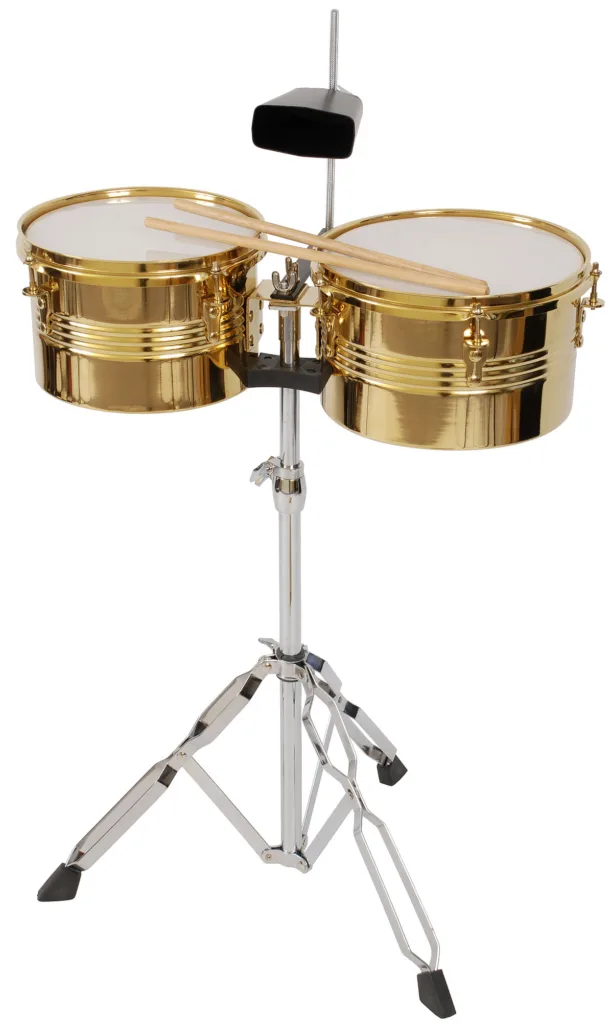The timbales, a percussion instrument of Afro-Cuban origin, have become an essential component of percussion setups in a variety of popular western music genres, including Salsa, Pop, Funk, and Rock’n’Roll.
Timbales, also known as pailas, are a set of shallow drums with a similar construction to timpani or kettledrums. The term timbales is derived from the Spanish word for timpani. The drums always come in pairs and are of different sizes, with one typically beng 13 inches and the other 14 inches.
The evolution of the timbales can be traced back to Cuba in the late 1800s. They originated from European timpani or kettle drums that were imported by Italian opera companies. The Cuban musicians adapted and modified these drums to create a distinct sound that suited their music. This led to the creation of the timbales, which quickly became an integral part of Cuban music.
The timbales consist of two drums, a larger one called the hembra and a smaller one called the macho. The drums are made of metal, typically steel, and have a shallow, cylindrical shape. The player strikes the drums with sticks or mallets to produce a sharp, crisp sound.
The timbales are usually played in conjunction with other percussion instruments such as congas, bongos, and cowbells. They are often used to provide rhythmic accents and fills, as well as to add excitement and energy to a piece of music.
In addition to their use in Cuban music, the timbales have also been incorporated into other genres such as Jazz, Latin Jazz, and Rock. Famous musicians who have used the timbales include Tito Puente, Sheila E, and Ginger Baker.
The timbales have a rich history and have become an essential instrument in various music genres across the world. Their unique sound and versatility have made them a popular choice for percussionists and musicians alike.
What Is A Timbal Used For?
A timbale, also known as timbales, is a percussion instrument that consists of a set of two shallow single-headed drums. It is commonly used in Latin American music genres, particularly in Afro-Cuban music, Salsa, and other similar styles. The timbales are played with sticks or hands, and their distinctive sound is achieved by striking the drumheads with different techniques and varying the pitch by tuning the drums.
The timbales are used to proide rhythmic patterns and accents in the music, adding a distinctive flavor to the overall sound. They are often played in conjunction with other percussion instruments such as congas, bongos, and cowbells, as well as with other instruments like the piano, bass, and guitar. In modern music, timbales have become an essential part of many musical genres, including jazz, funk, and rock, among others. They are used to add texture, depth, and complexity to the music, making them an essential part of any percussion set-up.

What Kind Of Instrument Is A Timbale?
A timbale is a percussion instrument that consists of a pair of shallow drums. These drums are similar in appearance to timpani or kettledrums. The word “timbales” is actually Spanish for “timpani.” Timbales are typically sold in pairs, with one drum measuring 13 inches in diameter and the other measuring 14 inches in diameter. They are often used in Latin American and Caribbean music genres, and can be played with either sticks or hands.
What Are Timbales In English?
Timbales are a type of dish that consists of a creamy mixture of meat or vegetables that is baked in a mold. The dish can also refer to the mold itelf in which the mixture is baked. In some cases, timbales can also refer to small pastry shells that are filled with a cooked timbale mixture. This dish is typically served as a side dish or as an appetizer and is popular in French and Italian cuisine. The term “timbale” is often used interchangeably with the term “timbal,” which refers to the same type of dish. timbales are a delicious and flavorful dish that can be enjoyed by food lovers around the world.
Who Invented The Timbales?
The invention of the timbales cannot be attributed to a single individual. However, the evolution of this percussion instrument can be traced back to Cuba in the late 1800s. The Timbales, also known as “Paila” and “Paila Criolla,” were derived from European Timpani, or kettle drums, that were brought to Cuba by Italian opera companies. The Timbales underwent significant changes in design and sound, and eventually became a prominent instrument in Latin American music. Therefore, it is safe to say that the Timbales were not invented by one person, but rater evolved over time through various influences and cultural exchanges.
Conclusion
The timbales are a unique and versatile percussion instrument that has stood the test of time. With their origins in Afro-Cuban music and their evolution from European timpani, they have become an integral part of many genres of music, from Salsa to Rock. Their distinctive sound, created by striking the metal shell with a stick or mallet, adds a lively and vibrant element to any musical piece. The timbales’ popularity can be attributed to their ability to complement a wide variety of musical styles and their adaptability to different playing techniques. Whether you are a professional musician or a casual listener, the timbales are sure to impress with their rich history and unmistakable sound.
